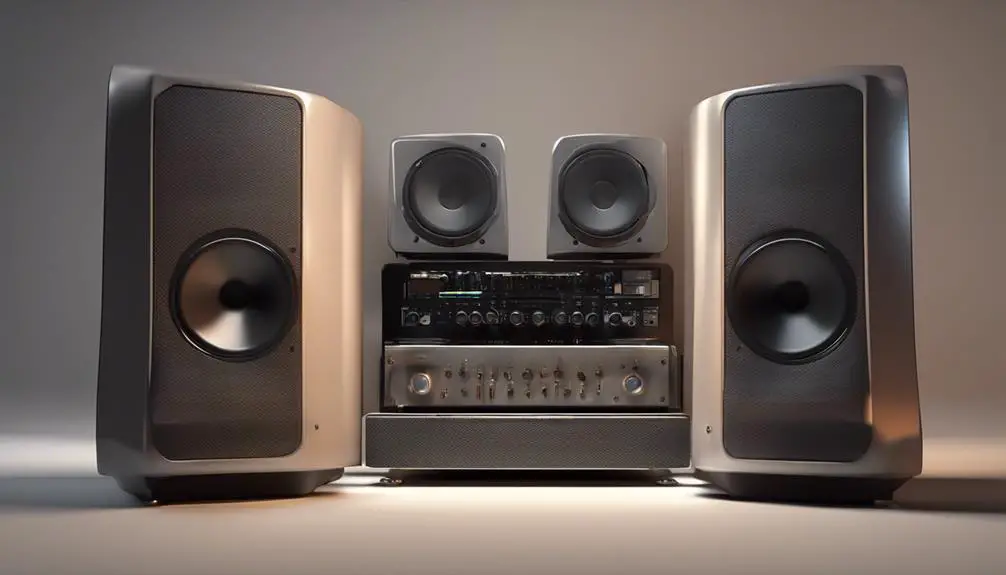When you consider passive speakers versus active speakers, you're faced with a choice between customization and convenience. While passive speakers offer a world of tailored audio experiences through external amplifiers, active speakers simplify your setup with built-in amplification. This distinction raises important questions about your own audio needs and preferences. Are you someone who values flexibility and control, or do you prefer a straightforward solution that just works? Understanding the nuances between these options could greatly impact your listening experience.
Definition of Passive Speakers
Passive speakers are those that require an external amplifier to drive them, relying on additional equipment to produce sound. This means you need to connect them to an amplifier or a receiver to enjoy your music or audio. Without this vital component, passive speakers won't function, leaving you without sound.
When you're setting up a sound system, it's important to understand how passive speakers fit into the equation. They typically have no built-in power source, so you can customize your audio experience by choosing an amplifier that matches your preferences. This flexibility can enhance your listening experience, but it also means you need to verify compatibility between components.
Safety should always be a priority when dealing with any audio equipment. Make sure your amplifier can handle the power requirements of your passive speakers to avoid damage. Also, when connecting wires, confirm everything is powered off to prevent any electrical shocks. To conclude, passive speakers offer a customizable sound experience, but they do require careful consideration of additional equipment to guarantee a safe and enjoyable listening environment.
Definition of Active Speakers
Active speakers are self-powered units that have built-in amplifiers, allowing you to connect them directly to audio sources without needing external equipment. This design makes them user-friendly and efficient, as you won't have to worry about separate amplifiers or complicated setups. You can easily plug your audio source, like a computer or smartphone, directly into the speaker.
With built-in amplifiers, active speakers often provide a balanced sound output, enhancing your listening experience. You'll also find that many models come with additional features, such as Bluetooth connectivity or equalization settings, which can further improve safety by confirming the sound is tailored to your environment.
When using active speakers, it's important to reflect on their power requirements. Verify you're using the correct voltage and that your power source is reliable to avoid potential hazards. Additionally, keep cables secure and out of the way to prevent tripping or other accidents.
Key Differences Between Types
One major difference between these speaker types is that active speakers have built-in amplifiers, while passive speakers rely on external amplification for sound. This distinction affects how you set up your audio system. Active speakers are generally easier to use since you won't need to buy and connect an external amplifier. On the other hand, passive speakers may require a bit more effort during installation, but they can offer greater flexibility regarding upgrading components.
Here's a quick comparison to help you understand the key differences:
| Feature | Active Speakers | |
|---|---|---|
| Amplification | Built-in amplifiers | Requires external amplifiers |
| Setup Complexity | Easier setup | More complex setup needed |
| Sound Quality | Often refined for their design | Depends on external components |
Choosing the right type of speaker can enhance your listening experience. If you're concerned about safety, remember that using the appropriate amplifier with passive speakers can help prevent damage and guarantee ideal performance. In contrast, active speakers simplify this process, making them a safer choice for those less experienced with audio setups.
Advantages and Disadvantages
Each type of speaker comes with its own set of advantages and disadvantages that can impact your audio experience. Active speakers usually offer a built-in amplifier, which means you won't have to worry about compatibility issues or additional equipment. This convenience makes them a great choice for those who want a straightforward setup. However, because they're self-powered, they can be more vulnerable to power surges, which might damage the internal components.
On the other hand, passive speakers require an external amplifier, giving you more control over your sound quality and customization options. This can be a plus if you're an audio enthusiast looking to tailor your setup. But keep in mind, you'll need to verify that your amplifier matches the speakers, which can lead to complexities in setup and safety concerns if not done correctly.
Choosing the Right Speaker
When deciding on the right speaker, consider your unique audio needs and how much control you want over your sound system. If you prefer a straightforward setup with minimal hassle, active speakers might be the way to go. They come with built-in amplifiers, simplifying your installation process and reducing the number of components you need, which can enhance safety by minimizing potential electrical issues.
On the other hand, if you value customization and have the technical know-how, passive speakers could be your best option. You can choose your amplifier and adjust settings according to your preferences, giving you more control over sound quality. Just make certain to pair them with the right equipment to avoid any mismatches that could lead to safety hazards.
Think about your space, too. Active speakers often save space and reduce clutter, while passive speakers may require additional equipment that could pose tripping hazards if not properly arranged. Ultimately, choose a speaker setup that fits your lifestyle and guarantees a safe environment while delivering the audio experience you desire.

